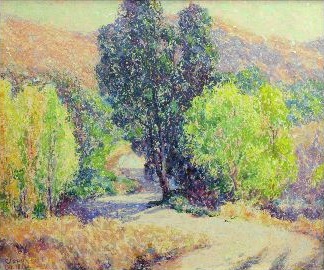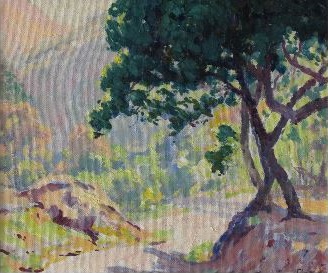
| Print | Back |  |
April 15, 2013 |
 |
Moments in Art Clapp's Ploy for Painter's Payby Lawrence Jeppson |
The Crash of 1929 left California painters in economic shambles.
William Henry Clapp (1879-1954), one of the founders of Oakland's Society of Six, was in better shape than most. For more than a decade he had been head of the Oakland Museum, and although his pay was meager, it was steady.
Earlier in his career, Clapp had been part of the art world in Montreal.
Clapp was seconded in the museum by Florence Weiben Lehre, a beautiful, intelligent, and vivacious woman twenty years younger than Clapp. Until her untimely death she was the voice of the museum and a dynamic supporter of living artists.
In February, 1930 Florence lamented that the goose was so dead that she knew of no Bay Region painter gaining a comfortable living by the production of easel paintings. Clapp defined comfortable living as $200 a month.
Solutions were sought. Clapp decided that museum juries had carried the spear that killed the goose. Juries were censors. And censors kept art out of shows that perhaps the public would buy. The public had to begin buying someone's paintings--it did not matter whose.
Lehre was devastating in her critique of the situation, and she was probably mirroring Clapp's feelings.
Today Northern California is notorious as one of the worst art markets in the United States . . . That our juries are functioning harmfully, suicidally, must be evident to any thoughtful artist who is not blinded by fanaticism. They created dislike and suspicions of all art and artists . . . We have killed the goose that laid the golden egg . . . .
A group of Clapp's friends back in Canada had created a group which was called The Seven about the same time the Society of Six was forming in California. The two groups were suffering parallel lives. A. J. Firestone remarked:
The Great Depression had struck Canada with a fury: mass unemployment, severe declines in incomes, crop failures, a dramatic drop in the price of wheat, protest marches, and soup kitchens were symptomatic of Canadian economic and social conditions during most of the thirties. (The Other A. Y. Jackson, p. 26.)
It is an apt description of what was happening in the United States. Jackson himself observed in his memoire, "Someone said to William Brymner [a noted art teacher in Montreal] that if artists had more business ability they could make a decent living, to which he retorted, 'In Canada an artist has to be a financial genius merely to stay alive.'" [Jackson, p. 194]
Clapp sent a paper to a meeting of the Western Association of Art Museums in San Diego (presumably his Board could not afford to send him personally) suggesting how artists might earn $50,000 a year. From poverty to pinnacles!
That was enough finally to make a back-East headline (15 October 1935) in The Art Digest, which was itself struggling and would die. Clapp declared that artists should adopt the semi-monthly practices of the business world to recover from the tremendous decline in the purchase of paintings. He figured there were 25,000,000 families in the United States which ought (and could) purchase one $10 painting a year. This would give 5,000 artists in America a $50,000 annual income.
Clapp was quoted as saying, "In general, it may be said that an original painting, if it is of the best quality of which the artist is capable, represents at least a month of an artist's life, including in its cost not only the price of materials, such as canvas and paints, but transportation while in search of subjects, unsuccessful sketches and painting time spent in thought and study, model hours, etc."
Clapp figured that an artist could copy his own original in a couple of hours, and these copies could be sold cheaply. To those who might fulminate that these would be potboilers just as much as a cascade of crummy originals, Clapp had a telling answer.
"A too large output of original works made primarily to sell, is ruinous to the artist, while copying on a somewhat . . . smaller scale of the artist's own work is both easy and does no harm. True enough, it is just plain work that lacks creative joy, but even an artist would be willing to work a bit, provided he is well paid for it."
Clapp had offered the idea, in his words, as a "fantastic plan" in order to call attention more strongly to the possibilities of the market for low-priced paintings. He created the controversy he sought and was only too happy to need nearly a full page for clarification in The Art Digest of 1 January 1936.
He averred that under the present methods of art encouragement and art merchandising there was little hope for the artist who paints easel pictures.
This being so, the necessity of some drastic change in methods is indicated. To confine ourselves to palliatives, such as futile little art clubs, petty sales galleries, dreary lectures to old ladies anent art appreciation, and to the thousand and one futilities by which we delude ourselves into the belief that we are doing great things for art, would be silly. At the best they merely transform the professional artist from an honest workman into a mixture of beggar and lounge lizard.
Clapp admitted that he did not expect anyone to take his $50,000 plan seriously. In fact, Clapp, calculated, at $10 a throw an artist would have to paint 5,000 pieces per year, 13.68 per day, which at two hours each, would require 27 hours of work every day of the year. He was really thinking on a more practical level, $200 or so per month.
Clapp hammered:
Painting originals primarily for sale means continual suppression of the new and personal in order to bring such work within the average person's very low powers of aesthetic appreciation. Painting 'to order' from originals created for any reason that pleased their authors, would leave the artist completely free. If, in the course of his flights above the common understanding he occasionally created, as all artists do, things of greater popular appeal, it would be possible to repeat these works 'to order' and thus gain the income needed for his support during still higher flights . . . For those artists who must paint potboilers I still believe that such a plan would be more effective and less harmful than painting large numbers of bad originals . . .
Clapp concluded with a dour observation.
No doubt there are many very young and hopeful persons who are still happy in the illusion that doing good creative work is a guarantee; that the financial situation of those who do will permit them to continue such work; that artistic merit will always be rewarded (financially); and that only the unworthy will fall by the wayside. To these, to those who have adequate private incomes, to the teachers who are comfortably placed, and to the artists who have found sustaining niches in commercial art, the matter of 'boiling the pot' by means of painting may seem unworthy of encouragement. However, if these happy ones could visualize the wasted lives, the suicides, the half-starved struggles of the many who are quite as talented as themselves, might be inclined to admit that our art institutions should devote more attention to the physical well being of our artists and less to floating on the clouds of pure and mostly ancient art.
Creative work in the arts has always been difficult. Even in today's affluence, there are many voices which, unfortunately, remain unheard. The situation during the Great Depression was far worse-for everyone.
There is no evidence that Clapp ever painted replicas. In his first years back in California he made many very fine monotypes, but each of these was an original, and from what I have seen, he did not make them after 1920. His suggestion was for others. He had his steady, albeit small, income from the city. He was one of the fortunates. But he saw with perfect clarity the plight of others and helped them whatever way he could.
During these bad years, at the same time Clapp was floating his ideas, the Federal government came up with a variety of rescue plans. Created in 1935, The Works Progress Administration put writers and historians to work creating guidebooks for every state in the union. Hundreds of artists were hired for pittances to paint murals in post offices and create other art. Much of this work was created by artists who later became well known.
In the 1960s one of my Bethesda neighbors employed by the General Services Administration realized that this art risked being lost and set out to catalog and preserve everything that was still extant. Since then 17,000 pieces of WPA art have been identified, and in most cases, GSA claims ownership.
Clapp's soundings helped dramatize the artists' plight. He was one of many voices crying for sympathy and rescue. The WPA didn't pay artists very much, but it kept some of them alive.


These two paintings were produced about the time Clapp was agitating for improved financial support for artists.
| Copyright © 2024 by Lawrence Jeppson | Printed from NauvooTimes.com |